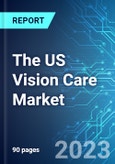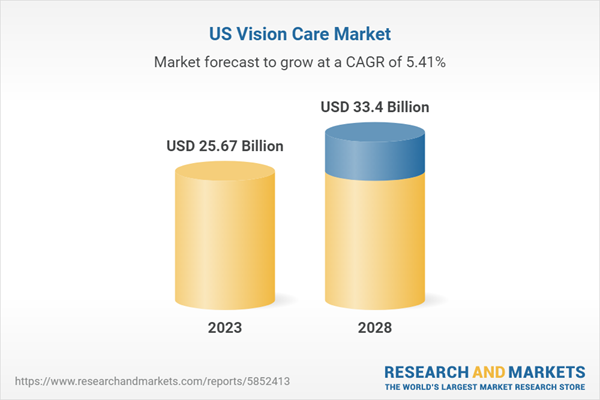Vision care refers to product & services that are employed for maintaining the quality of eyes, eyesight conditions, vision, and eye disorders. Vision care market is associated with design, manufacturing and sale of products & services related to maintaining and improving the quality and functioning of the eyes, where eye care products include glass lenses, contact lenses, contact solutions, artificial tears, etc., and vision care treatment solutions include ointments, drops, pills and surgeries. The US vision care market was valued at US$24.35 billion in 2022. The market value is forecasted to grow to US$33.40 billion by 2028.
Rising consumer preference for branded eye care products, increasing cases of diabetes in the region, rapid adoption of electronic devices among children & working adults, wide availability of vision care products through various distribution channels, such as hospitals, clinics, retail, & online stores, increasing sedentary lifestyle and rising prevalence of vision-related ailments, such as cataracts, glaucoma, conjunctivitis, refractive errors, color blindness, amblyopia, and astigmatism, among different age groups in the US population, etc., have been positively contributing towards increased demand for vision care products. Other significant factors are digitalization, strong logistics and supply chain network, highly developed healthcare infrastructure, favorable reimbursement policies by the government, increasing demand for lightweight, cost-effective, scratch resistant, & comfortable eyewear among individuals, and rising number of new product launches and innovations in the market by vision care companies to remain competitive in the market and strengthen their current portfolios. The market is anticipated to grow at a CAGR of approx. 5.41% during the forecasted period of 2023-2028.
Market Segmentation Analysis:
- By Product: The report provides the bifurcation of the market into four segments on the basis of product: prescription glasses, contact lens, intraocular lens, and others. The prescription is both the largest and the fastest growing segment of the US vision care market owing to increasing cases of myopia (nearsightedness) and hyperopia (farsightedness), wide product offering of varying cost range provided by local and online retailers, increasing demand for stylish and trendy eye frames to complement personal style and fashion preferences, rising adoption of high quality sunglasses as a result of increasing awareness of ocular diseases caused by UVA and UVB rays, increasing demand for bifocal and progressive reading eye glasses among older population and added benefits associated with eye glasses in terms of non-invasiveness, cost-effectiveness, low maintenance, and lower risk of eye infections and allergies.
- By Distribution Channel: The report provides the bifurcation of the market into four segments based on distribution channel: retail stores, e-commerce, clinics, and hospitals. The retail store is the largest segment of the US vision care market owing to, rapidly expanding retail sector, immediate purchasing experience provided by retail stores, rising use of eye care products as fashion accessories, and added benefits associated with retail stores in terms of personalized assistance to customers, face-to-face consultations with opticians, and provision of fitting and adjustment services.
- E-commerce is the fastest growing segment of the US vision care market, driven by increasing internet penetration, rapidly expanding e-commerce sector, strong logistics and supply chain networks, and increasing number of benefits offered by online channels in terms of discounts, free home delivery, virtual try-on features, 24/7 accessibility, and customer reviews and ratings for eye care products.
Market Dynamics:
- Growth Drivers: Increasing electronic devices and media usage time is a prominent growth driver of the US vision care market. Increasing visual demand of modern occupation, ongoing digitalization of educational systems, exponential growth of digital gadgets, and proliferation of mobile applications, social media platforms and digital entertainment options, are associated with reduced blink rate, increased risk of myopia development and rising number of people experiencing eye related problems such as asthenopia, computer vision syndrome (CVS), retinal degeneration, etc., resulting in eye fatigue, dryness, blurred vision, and itching, burning, and a gritty sensation. For instance, according to the Vision Council, at least 60% of American men and 65% of American women reported symptoms of CVS due to increasing use digital devices. Therefore, increasing electronic devices and media usage time will continue create a positive demand for vision care products and services. Further, the US vision care market has been rapidly growing over the past few years, due to factors such as growing geriatric population, expanding retail e-commerce, increasing incidence of chronic diseases, supportive government policies, growing incidence of vision impairment disorders, etc.
- Challenges: However, the market growth would be negatively impacted by various challenges such as increase in the cases of eye infection due to contact lenses, rising constraints on business practices, presence of counterfeit products, etc. The most common problem associated with contact lenses is dry eye syndrome as reduced tear film stability and increased evaporation due to lens wear can cause dryness, irritation, and discomfort. Also, lack of awareness and improper handling & poor hygiene practices when using contact lenses can cause irritation, increasing risk of eye infections such as bacterial keratitis and fungal keratitis, and rise in likelihood of developing different forms of eye allergies, leading to discomfort, vision impairment, and potential long-term consequences to overall eyes. Therefore, increasing number of cases of eye infections is expected to negatively impact the demand for contact lenses in the country, impending the growth of the US vision care market.
- Trends: The market is projected to grow at a fast pace during the forecasted period, due to various latest trends such as integration of artificial intelligence (AI) and machine learning (ML), ongoing advancements in vision care, growing awareness of UV rays related visual impairment, increasing number of innovations and product launches in the market, growing preference for daily disposable contact lenses (single-use), shifting focus from eye care to lifelong personal vision care, etc. Prolonged exposure to UV radiation, particularly UV-B and UV-C rays can increase the risk of developing a number of eye diseases & conditions, such as cataracts, macular degeneration, pterygium, and photokeratitis etc., leading to vision impairment and in severe cases, even blindness. UV rays exposure can also lead to premature aging of the eyes, increased damage to the cornea and conjunctiva, and greater susceptibility to glare, which can cause visual discomfort, enhanced difficulty in seeing objects clearly, and reduced visual performance in certain activities. Therefore, growing awareness of UV rays related visual impairment has been positively to the growth of the US vision care market over the forecasted period of 2023-2028.
Impact Analysis of COVID-19 and Way Forward:
COVID-19 brought in many changes in the world in terms of reduced productivity, loss of life, business closures, closing down of factories and organizations, and shift to an online mode of work. In 2020, the highly infectious nature, hospitalization and mortality rates associated with COVID-19, impacted clinical care for many life-threatening conditions, shifting concerns away from non-fatal conditions that cause only morbidity or disability, including vision impairment and eye disorders. Lockdown policies, imposed by the government to prevent the spread of virus resulted in suspension or delay of optometric, medical, surgical, screening and clinical trial activities, along with limited access to eye care facilities and postponement or cancellations of many routine eye care appointments unless immediate eye care was necessary. So, the overall impact of COVID-19 pandemic on the US vision care market turned out to be negative as a result of non-availability of eye care practitioners, delays in conducting vision surgeries and procedures, and temporary closure of other office-related treatment alternatives.
Competitive Landscape:
The US vision care market is relatively fragmented with increasing number of regional and local players catering to the vision care demand. As of 2021, the top 10 players in the US optical retail market are responsible for nearly 40% of sales. whereas the top 50 players in the US optical retail industry are only responsible for just under half of total sales. The remainder remains fragmented, with many single unit, independently owned practices.
The key players of the market are:
- Alcon Inc.
- ZEISS Group
- EssilorLuxottica SA (Essilor of America, Inc.)
- Johnson & Johnson Inc. (Johnson & Johnson Vision)
- HOYA Corporation
- Bausch + Lomb Incorporated
- Cooper Companies Inc. (CooperVision)
- Menicon Co., Ltd.
- National Vision Holdings, Inc.
- Rayner Group
The major players are increasingly engage in various research & development activities and initiatives to deploy new and more efficient products in the market and gain larger market share. For instance, on January 18, 2023, CooperVision Specialty EyeCare announced the launch of company’s pioneering digital fitting tool, Visavy (pronounced Vee-SAH-vee) at 2023 Global Specialty Lens Symposium (GSLS), where the easy-to-use, web-based fitting software incorporates topography-guided algorithms to assist the design and selection of Paragon CRT orthokeratology contact lenses for myopia management.
Table of Contents
1. Executive Summary
Companies Mentioned
- Alcon Inc.
- ZEISS Group
- EssilorLuxottica SA (Essilor of America, Inc.)
- Johnson & Johnson Inc. (Johnson & Johnson Vision)
- HOYA Corporation
- Bausch + Lomb Incorporated
- Cooper Companies Inc. (CooperVision)
- Menicon Co., Ltd.
- National Vision Holdings, Inc.
- Rayner Group
Table Information
| Report Attribute | Details |
|---|---|
| No. of Pages | 90 |
| Published | July 2023 |
| Forecast Period | 2023 - 2028 |
| Estimated Market Value ( USD | $ 25.67 Billion |
| Forecasted Market Value ( USD | $ 33.4 Billion |
| Compound Annual Growth Rate | 5.4% |
| Regions Covered | United States |
| No. of Companies Mentioned | 10 |









